Spatial audio on headphones creates a 3D sound experience by simulating how we naturally hear directional, height, and depth cues. It uses advanced algorithms, like HRTF, to reproduce sounds as if they’re around you, making audio feel more lifelike and immersive. Head tracking can enhance this further by adjusting sound based on your movements. If you want to understand how it all works and improves your listening, keep exploring these key concepts.
Key Takeaways
- Spatial audio creates a 3D sound environment by simulating sound sources from different directions around the listener.
- Headphones use algorithms and HRTF data to accurately localize sounds in space, mimicking natural hearing cues.
- Personalization, such as ear shape and head size, improves spatial accuracy but is often limited by standardized HRTFs.
- Features like head-tracking adjust sound based on head movement, enhancing immersion and realism on headphones.
- Advanced spatial audio formats (e.g., Dolby Atmos) enable dynamic, multi-dimensional sound experiences through compatible headphones.
What Is Spatial Audio and How Does It Differ From Traditional Sound
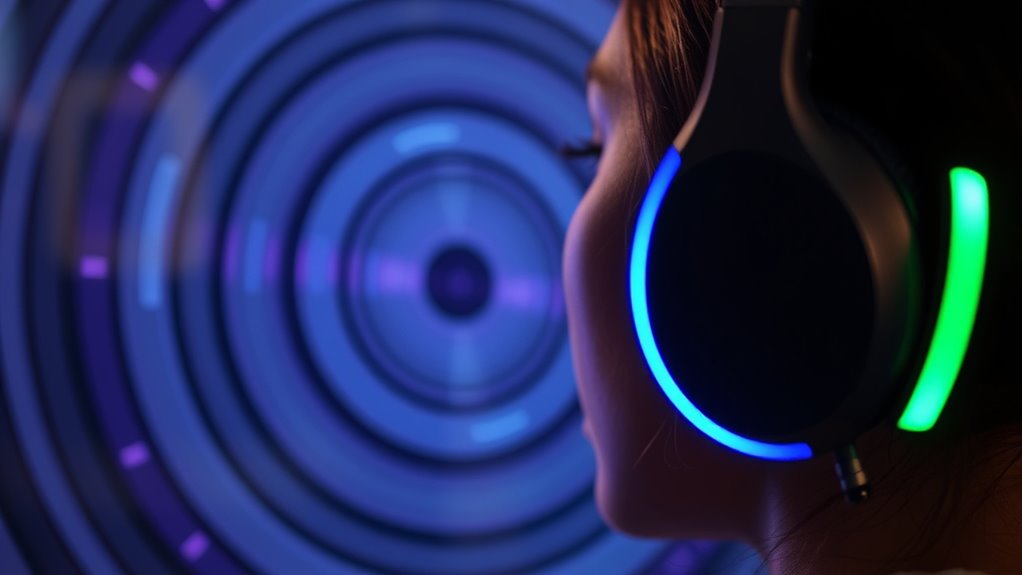
Spatial audio creates a 3D sound environment that makes it feel like sounds are coming from all around you, not just from the left and right channels. Unlike traditional stereo audio, which only separates sounds into two channels, spatial audio adds height and depth, mimicking natural hearing. It places sounds within a 360-degree sphere, including above and below you, for a more lifelike experience. While stereo relies on simple left-right separation, spatial audio uses advanced algorithms and object-based coding to position sounds dynamically. This creates a richer, more immersive environment where sounds seem to come from specific directions and distances. AI security innovations are also being explored to enhance the safety and reliability of such immersive technologies, ensuring user trust. The result is a sense of realism and precise localization, making you feel truly inside the audio landscape. Additionally, ongoing research into sound localization continues to improve the accuracy and realism of spatial audio experiences, benefiting both entertainment and safety applications. Moreover, improvements in processing power enable more sophisticated spatial audio rendering in real-time, enhancing user experience across various devices. Furthermore, the development of head-tracking technology allows the audio environment to adjust in real-time as you move, enhancing immersion even further.
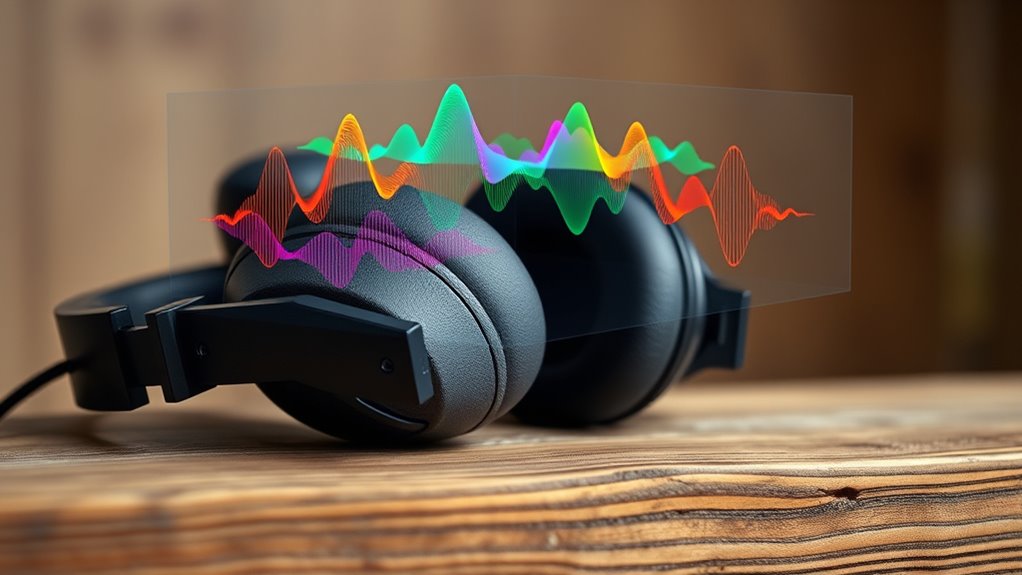
The Head-Related Transfer Function (HRTF) is a crucial element in creating realistic 3D sound experiences through headphones. It characterizes how your unique head, ears, and torso filter incoming sounds from different directions. HRTF captures the frequency response at each ear, showing how sounds are altered by your anatomy, including resonances around 2–5 kHz that boost certain frequencies. This filtering helps your brain interpret spatial cues, including elevation and front-back location, which binaural cues alone can’t fully resolve. Factors like ear shape, head size, and torso influence your HRTF, making it highly individualized. Typically measured with microphones at the ear canal, HRTFs provide data that enable headphones to simulate how sounds originate in 3D space, enhancing your auditory perception.
How Spatial Audio Is Created for Headphones
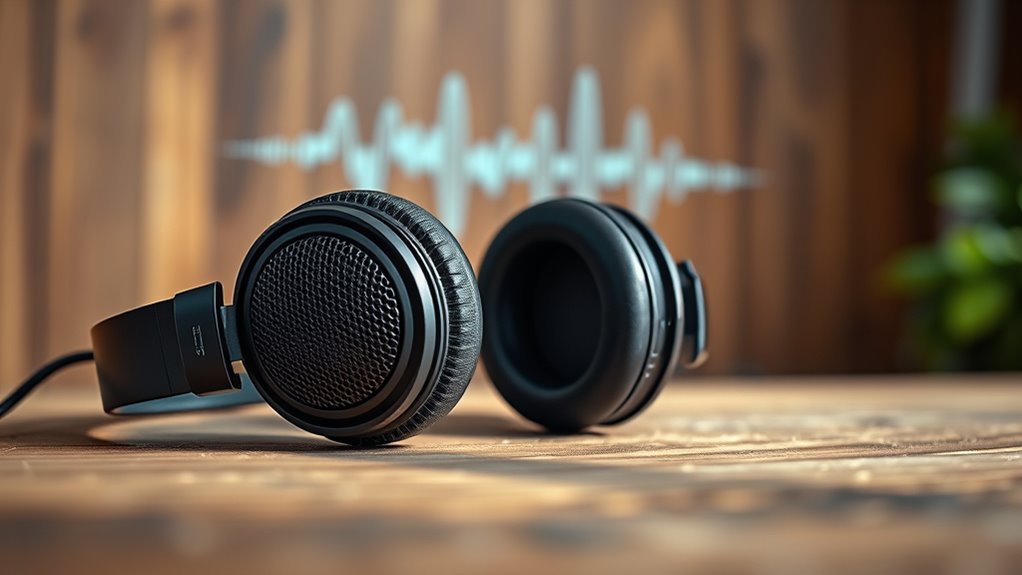
Creating immersive sound experiences on headphones involves a combination of advanced software techniques that position audio elements within a virtual 3D space. You start with digital audio workstations that process multichannel streams and apply HRTF-based algorithms to simulate how sounds reach your ears from different directions. Spatial audio plugins, like Dolby Atmos or THX Spatial, enable precise placement of sounds in three dimensions. Binaural algorithms replicate natural localization cues, making sounds seem to come from specific points around you. Object-based audio formats allow dynamic positioning, while motion automation tools make sounds move realistically, such as overhead or behind. By combining these methods, developers craft a convincing sense of space, depth, and motion — all optimized for headphone listening.
Key Technologies Powering Spatial Audio Experiences

Advancements in signal processing algorithms form the backbone of immersive spatial audio experiences on headphones. These techniques convert ordinary audio into spatial formats, allowing sound to appear around you in real time. Software integration enhances performance, guaranteeing ideal positioning and timing of sounds. External amplifiers can boost audio clarity and detail, especially in high-end setups. Depending on your device and platform, different processing methods are employed to create realistic spatial effects. Binaural recording captures sound as human ears perceive it, placing audio precisely in virtual space, while object-based systems like Dolby Atmos manipulate individual sound objects for a 360-degree experience. Headphone design innovations, such as custom drivers and noise-canceling features, further enhance immersion. Compatibility across devices and platforms ensures you can enjoy consistent spatial audio quality wherever you listen.
Popular Spatial Audio Formats and Systems

Various spatial audio formats have gained popularity for delivering immersive sound experiences on headphones. Dolby Atmos, launched in 2012, uses object-based audio and metadata to place sounds precisely in 3D space, creating rich surround sound. Sony’s 360 Reality Audio also employs object-based techniques, providing immersive music experiences with metadata-driven positioning. Apple Spatial Audio combines Dolby Atmos decoding with proprietary head tracking, making sounds move dynamically relative to your head for enhanced immersion on AirPods and Beats headphones. Qualcomm’s Snapdragon Spatial Audio, integrated into Snapdragon chips, supports active head tracking and is used in many Android devices. MPEG-H Audio blends channel, object, and binaural formats for flexible immersive playback. Ambisonics captures a full 360° sound sphere, ideal for VR and AR, requiring specialized decoding for headphones. Additionally, AI-powered spatial audio enhances the accuracy and realism of sound placement, further elevating the immersive experience. Incorporating spatial awareness into audio processing can significantly improve the precision of sound localization and overall immersion, especially as technological developments continue to evolve.
Practical Uses of Spatial Audio in Entertainment and Gaming
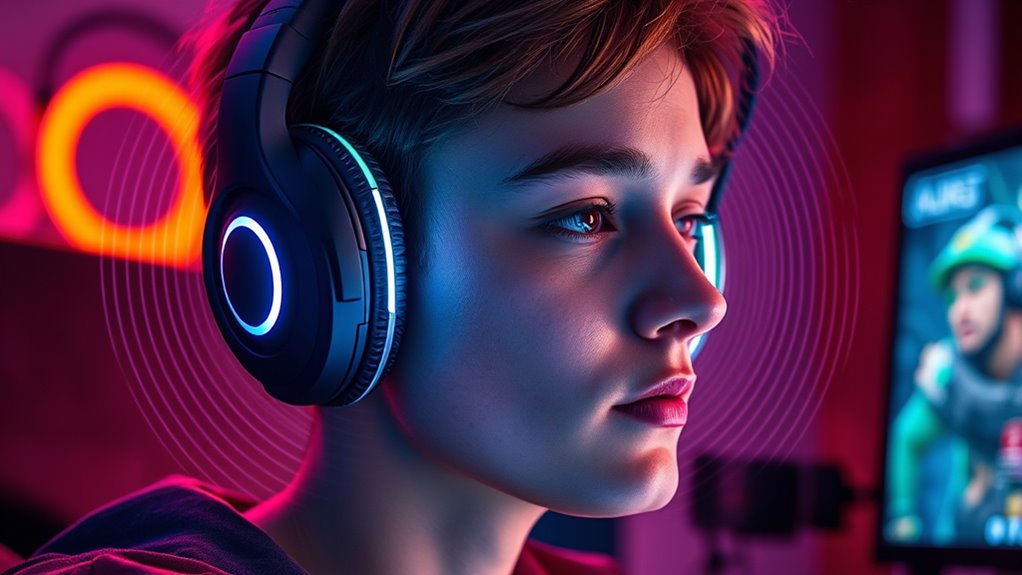
Spatial audio transforms your entertainment and gaming experiences by immersing you in a 3D sound environment, making it feel like you’re right there in the action. Streaming platforms like Netflix, Apple TV+, and Disney+ support Dolby Atmos, delivering dynamic soundscapes that position effects such as rain or footsteps precisely. You can enjoy Atmos on headphones, soundbars, or home theaters without extra equipment. In gaming, technologies like THX Spatial Audio provide 7.1 surround sound, helping you locate enemies through directional cues. Compatibility spans headsets and PCs, with scene-specific adjustments for different environments. Personalization features, like Apple’s hearing profiles and head-tracking, optimize your listening. These practical applications make entertainment more immersive and engaging, whether you’re watching a film, exploring a virtual world, or competing in a game. Additionally, best hot rollers for long hair can enhance your look with minimal effort, making your overall experience more satisfying. As AI-driven technologies advance, spatial audio customization is becoming more accessible, allowing users to tailor their sound experiences to their preferences and environment.
Benefits of Using Spatial Audio on Headphones
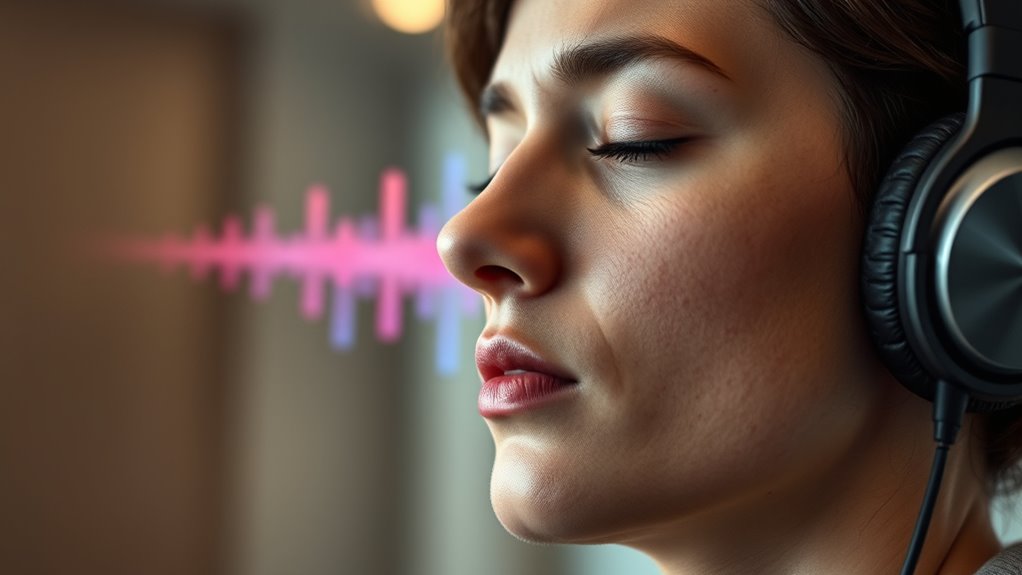
Using spatial audio on headphones markedly enhances your sound experience by providing clearer, more realistic audio quality. It creates a more immersive environment, making you feel like you’re right there in the scene. With a lifelike soundstage, sounds seem to come from precise directions, improving clarity and accuracy. You can better perceive the depth and distance of audio sources, adding richness to your listening. As you move your head, spatial audio dynamically adjusts, offering a natural, real-life perception. It enables precise localization of sounds, helping you identify where noises originate. This technology also enhances storytelling and gaming by creating a multi-dimensional sound environment. Additionally, mastering Jeep Tuning techniques can improve your vehicle’s audio system, further enriching your listening experience. Understanding spatial audio technology can help you optimize its benefits for your specific needs. Being aware of audio perception principles can help you better interpret and utilize the spatial cues for an even more immersive experience. Overall, spatial audio on headphones elevates your listening, making it more engaging, accurate, and true to life.
Challenges in Achieving Accurate Spatial Sound
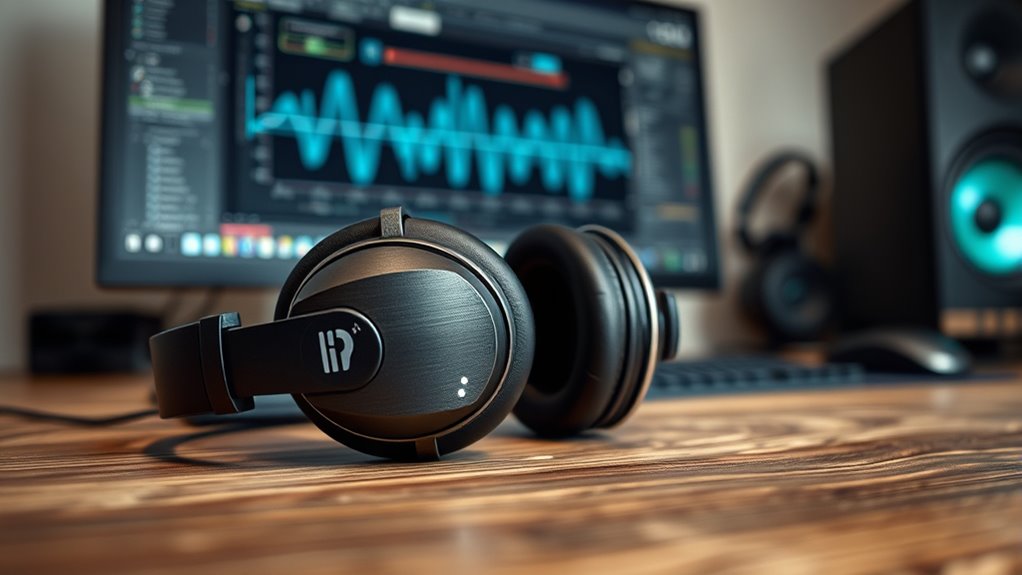
Achieving accurate spatial sound on headphones faces several significant challenges rooted in individual differences and technical limitations. Your unique ear, head, and torso shapes influence how sound waves are filtered before reaching your eardrums, affecting spatial cues. Since standardized HRTFs don’t account for personal anatomy, many users experience imprecise localization. Customizing HRTFs is complex and costly, making it difficult to tailor experiences for everyone. Variations in ear canal and pinnae shape also impact how you perceive spatial cues, reducing the effectiveness of one-size-fits-all approaches. Additionally, latency issues from processing and head-tracking can cause noticeable errors in sound source direction, especially in wireless setups. These technical and anatomical factors combine to hinder the delivery of truly accurate, immersive spatial audio experiences. Understanding credit card terms is essential for personal finance management, especially when considering investments in high-quality audio equipment.
Enhancing Your Listening Experience With Spatial Audio Settings

Enhancing your listening experience with spatial audio settings is straightforward and customizable, allowing you to tailor sound to your preferences. First, personalize your spatial audio by scanning your ear and head shape with compatible devices like iPhone X or later, creating a profile that optimizes spatial perception. This profile syncs across Apple devices sharing your Apple ID, ensuring a consistent experience. You can enable spatial audio through system settings on devices like Windows, iPhone, iPad, or Mac, and adjust head tracking options for a more immersive feel. Software solutions like SteelSeries Sonar let you fine-tune the spatial sound, adjusting virtual speaker positions and mixing channels. These settings help you enjoy supported content—movies, music, or games—with enhanced depth, clarity, and a more natural soundstage. Additionally, understanding spatial audio fundamentals can help you further optimize your listening environment for the best immersive experience. Being aware of privacy and cookie usage can also ensure your preferences are maintained while customizing your audio experience. Exploring sound quality settings further can enhance your overall auditory experience by fine-tuning the output to your liking. Experimenting with different audio configurations can reveal new layers of sound detail and immersion, especially when combined with knowledge about relationship dynamics and how sound influences emotional perception, which can deepen your appreciation of immersive audio content.
Future Trends and Developments in Spatial Audio Technology
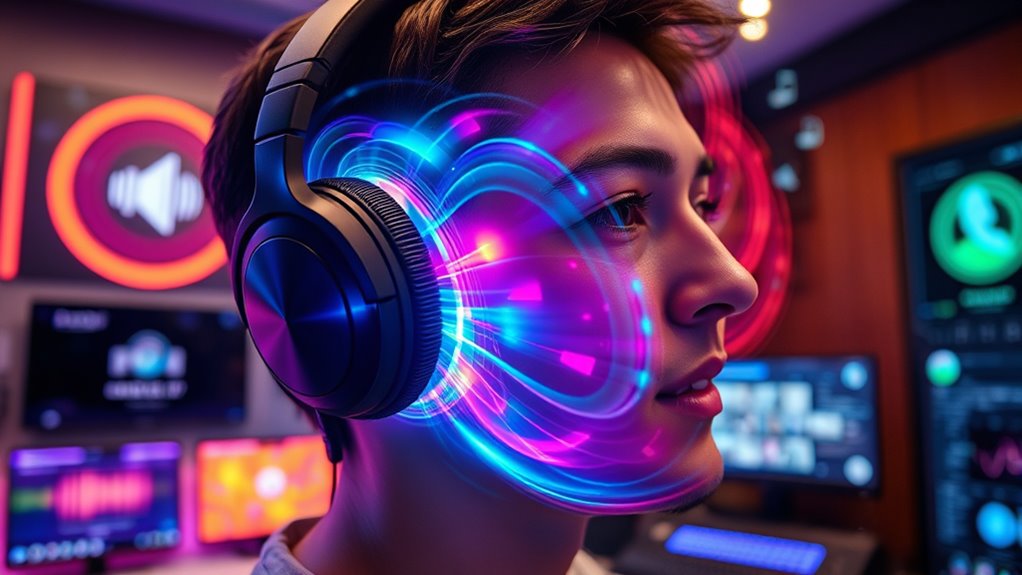
Advances in spatial audio algorithms and emerging technologies are shaping a more immersive and realistic listening landscape. Enhanced 3D soundscaping creates precise source localization, making virtual environments feel more authentic. Innovative layering and directional techniques boost immersion in VR, gaming, and films. Adaptive systems now dynamically adjust sound based on user movements and surroundings, increasing realism. Integration of electrostatic speakers offers clearer, detailed spatial sound while being environmentally conscious. Multi-speaker setups expand beyond headphones, creating seamless 3D environments in homes and public spaces. AI plays a key role, automating sound enhancement, simplifying content creation, and personalizing experiences in real time. Wireless tech like Bluetooth 5.0 improves delivery quality, reduces latency, and extends battery life, ensuring more seamless and immersive spatial audio experiences across platforms. Additionally, ongoing research into divorce statistics and regional legal resources is fostering a broader understanding of the social and legal landscape that can indirectly influence consumer interests in innovative audio technologies. Furthermore, innovations in sound localization algorithms are increasing the precision with which virtual sound sources are rendered, enhancing user immersion. Exploring industry trends helps developers stay ahead in this rapidly evolving field, ensuring that new products meet consumer expectations. Moreover, advancements in user movement tracking are enabling more accurate adjustments to sound positioning, further elevating the realism of spatial audio experiences. Recent developments in environmental sensing are also contributing to more dynamic and context-aware audio experiences, bridging the gap between virtual and real-world interactions.
Frequently Asked Questions
Can Spatial Audio Be Personalized for Individual Ear Shapes?
Yes, you can personalize spatial audio for your ear shape. Using your iPhone’s TrueDepth camera, you’ll scan your ears and head, creating a custom audio profile. This process adjusts sound placement and movement, making the experience more natural and immersive. Once set up, you can toggle the personalization on or off, ensuring your audio feels perfectly tailored to your unique anatomy for movies, music, and calls.
How Does Latency Affect Spatial Audio Performance?
Latency is the heartbeat of spatial audio, dictating how smoothly the sound moves with your head. When delays creep in, it’s like a dance losing its rhythm—sounds lag behind your movements, breaking immersion and causing disorientation. You’ll notice cues feeling out of sync or jittery, especially in VR or gaming. Reducing latency keeps your audio in step, making the experience feel natural, immersive, and more responsive to your every move.
Are All Headphones Compatible With Spatial Audio Features?
Not all headphones support spatial audio features. Compatibility depends on the device’s hardware, software, and content format. Some headphones, like Apple’s AirPods Pro and certain Sony or LG models, are designed for spatial audio, especially with head tracking. Other headphones can simulate spatial sound through software or Dolby Atmos support. Check your device’s specifications to see if it’s compatible, as not every headphone offers this immersive experience.
What Is the Difference Between Object-Based and Channel-Based Spatial Audio?
The difference between object-based and channel-based spatial audio lies in how they create a sense of space. With object-based audio, each sound is treated as an independent object, allowing dynamic placement and movement in 3D space, which enhances immersion. Channel-based audio uses fixed channels, like stereo or surround sound, to simulate space. It’s less flexible, with sounds confined to specific directions, making it more limiting but simpler to produce.
How Does Spatial Audio Impact Hearing Health Over Extended Use?
You wonder how extended use of spatial audio affects hearing health. While spatial audio can promote relaxation and potentially reduce stress, prolonged exposure to loud sounds can still cause hearing damage, regardless of format. Headphones may limit natural sound cues and require careful volume control. To protect your hearing, keep the volume moderate, take regular breaks, and use features that reduce loud noises. Regular hearing tests are also recommended.
Conclusion
Don’t let worries about complexity stop you from enjoying spatial audio. Once you understand the basics, it’s easier to immerse yourself in richer, more realistic sound experiences on your headphones. Whether for gaming, movies, or music, spatial audio brings your content to life. Just give it a try—most devices are user-friendly, and the incredible depth is worth it. Embrace this technology, and elevate your listening to a whole new level.









